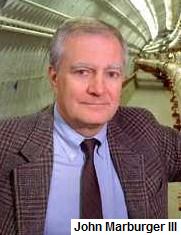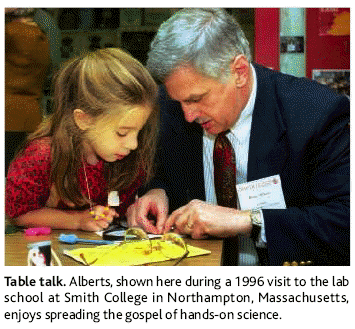|
Opinion- 24 May 2005 |
|
US Science Present and Future: Some Views from Bruce Alberts and John Marburger |

Bruce Alberts is the outgoing President of the US National Academy of Sciences. Having served 12 years in the office the 67 year-old is now returning to the University of California, San Francisco (UCSF) to reclaim his professorship of Biochemistry and Biophysics. On the eve of his return to the West Coast he gave an extensive interview to Science where he told it as he sees it.
John H. Marburger III is director of the Office of Science and Technology Policy, Executive Office of the President of the United States, i.e. he is science advisor to President George W. Bush. Dr Marburger contributed the editorial to the May 20 Science, "Wanted: Better Benchmarks".
He opens his editorial with the questions, "How much should a nation spend on science? What kind of science? How much from private versus public sectors? Does demand for funding by potential science performers imply a shortage of funding or a surfeit of performers?"
As one of Australia's leading academics pointed out to TFW, these questions are at least as important for Australia as they are for the United States, for example, "In Australia there is a dispute between scientists and the Treasury Secretary, Ken Henry, as to whether science contributes much to the economy. Henry claims it contributes no more than is spent on it, and so spending on science is much like spending on the arts. Henry is not a political appointee. He is respected by many people, on the left and on the right alike, even if they think [as our scientists do] that his models are wrong."
 So
far as the United States is concerned John Marburger would appear to disagree
with Ken Henry, "The question is not whether R&D investments are important, but
what investment strategies are most effective in the rapidly changing global
environment for science," and goes on to observe, "Here, ideas diverge...
Resolution of this issue requires a broader understanding of socioeconomic
factors in a number of nations that would allow us to attach probabilities to
different future scenarios... [but] benchmarks do not speak for themselves. The
data we choose to collect do say something about the framework in which we
understand the relations among science, government, and society."
So
far as the United States is concerned John Marburger would appear to disagree
with Ken Henry, "The question is not whether R&D investments are important, but
what investment strategies are most effective in the rapidly changing global
environment for science," and goes on to observe, "Here, ideas diverge...
Resolution of this issue requires a broader understanding of socioeconomic
factors in a number of nations that would allow us to attach probabilities to
different future scenarios... [but] benchmarks do not speak for themselves. The
data we choose to collect do say something about the framework in which we
understand the relations among science, government, and society."
Dr Marburger puts forward the belief, "The old budget categories of basic and applied R&D, still tracked by the U.S. Office of Management and Budget, do not come close to capturing information about the highly interdisciplinary activities thought to fuel innovation... A recent report from the NRC [National Research Council] Committee on National Statistics found that 'the structure of . . . data collection is tied to models of R&D performance that are increasingly unrepresentative of the whole of the R&D enterprise.' Further, 'It would be desirable to devise, test and, if possible, implement survey tools that more directly measure the economic output of R&D in terms of short-term and long-term innovation.'"
Finally, while Dr Marburger offers no concrete suggestions as to the path forward he concludes, "We need econometric models that encompass enough variables in a sufficient number of countries to produce reasonable simulations of the effect of specific policy choices... As more economists and social scientists turn to these issues, the effectiveness of science policy will grow, and of science advocacy too."
The NRC Committee on National Statistics' parent body is the US National Academy of Sciences, and among the matters the retiring President Bruce Alberts discussed with Science, was "on advising government".
Perhaps somewhat wryly Professor Alberts opened with, "The Bush Administration [in 2001] asked us 14 specific questions about climate change, and I give them credit for asking. They didnít have to... [Some] keep saying that climate change isnít real, and that the science isnít there. Weíve answered that question, and weíre going to continue to insist on those answers, whether they like it or not." And he went on with the admission, "One big mistake I made as NAS president was to hold a competition within the academy for topics that we should study. We came up with lots of good ideas. But there was no client for them, so they had little effect. Getting an agency to put up even a little money for a study makes a big difference in their interest." (our emphasis)
And as if to start an answer to John Marburger's plea for benchmarks, "I think the countries that will lead the world in science and technology are not just those with the most people. That's important. But you also need a system that allows the most talented people to have access to what they need to function effectively. Encourage the collision of ideas, and reward risk-taking and innovation. The United States is trying to do those things, too, but not well enough."
Surely implicit in that conclusion is the admonition that overbearing top-down decision making is destructive and self defeating.
Alex Reisner
The Funneled Web
Photo Credits: Marburger - Brookhaven; Alberts Science, portrait - Chris Maddaloni; table talk - Carol Lollis.